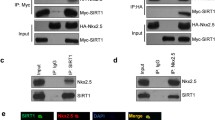Abstract
A delicate balance exists between cell growth and cell death. In the context of the adult myocardium, inappropriate or inordinate cell loss through an apoptotic process may profoundly influence cardiac structure, function, or both given the limited and meager ability of the heart for repair after injury. Earlier work by the authors’ laboratory identified a close relation between cell cycle factor E2F-1 and hypoxia-inducible factor Bnip3 as the key regulator of apoptosis and autophagy in ventricular myocytes. Epigenetic changes by histone-modifying proteins, namely, histone deacetylases (HDACs) influence cell survival by altering the activity of histone core proteins, transcription factors, or both. This report highlights the intricate nature between the cellular factors E2F-1 and nuclear factor-κB (NF-κB) and the epigenetic regulation of Bnip3 gene transcription by HDAC1 for cell survival of ventricular myocytes.

Similar content being viewed by others
References
Baetz D, Regula KM, Ens K, Shaw J, Kothari S, Yurkova N, Kirshenbaum LA (2005) Nuclear factor-kappaB-mediated cell survival involves transcriptional silencing of the mitochondrial death gene BNIP3 in ventricular myocytes. Circulation 112:3777–3785
Chiche J, Rouleau M, Gounon P, Brahimi-Horn MC, Pouyssegur J, Mazure NM (2010) Hypoxic enlarged mitochondria protect cancer cells from apoptotic stimuli. J Cell Physiol 222:648–6573
Cloud JE, Rogers C, Reza TL, Ziebold U, Stone JR, Picard MH, Caron AM, Bronson RT, Lees JA (2002) Mutant mouse models reveal the relative roles of E2F1 and E2F3 in vivo. Mol Cell Biol 22:2663–2672
DeGregori J, Leone G, Ohtani K, Miron A, Nevins JR (1995) E2F-1 accumulation bypasses a G1 arrest resulting from the inhibition of G1 cyclin-dependent kinase activity. Genes Dev 9:2873–2887
Ding WX, Ni HM, Li M, Liao Y, Chen X, Stolz DB, Dorn GW II, Yin XM (2010) Nix is critical to two distinct phases of mitophagy, reactive oxygen species-mediated autophagy induction and Parkin-ubiquitin-p62-mediated mitochondrial priming. J Biol Chem 285:27879–27890
Dorn GW II (2010) Nix Nought nothing: fairy tale or real deal. J Mol Cell Cardiol [Epub ahead of Print]
Galvez AS, Brunskill EW, Marreez Y, Benner BJ, Regula KM, Kirshenbaum LA, Dorn GW II (2006) Distinct pathways regulate proapoptotic Nix and BNip3 in cardiac stress. J Biol Chem 281:1442–1448
Hallstrom TC, Mori S, Nevins JR (2008) An E2F1-dependent gene expression program that determines the balance between proliferation and cell death. Cancer Cell 13:11–22
Karin M (2009) NF-kappaB as a critical link between inflammation and cancer. Cold Spring Harb Perspect Biol 1:a000141
Mazure NM, Pouyssegur J (2009) Atypical BH3-domains of BNIP3 and BNIP3L lead to autophagy in hypoxia. Autophagy 5:868–869
Novak I, Kirkin V, McEwan DG, Zhang J, Wild P, Rozenknop A, Rogov V, Lohr F, Popovic D, Occhipinti A, Reichert AS, Terzic J, Dotsch V, Ney PA, Dikic I (2010) Nix is a selective autophagy receptor for mitochondrial clearance. EMBO Rep 11:45–51
Shaw J, Zhang T, Rzeszutek M, Yurkova N, Baetz D, Davie JR, Kirshenbaum LA (2006) Transcriptional silencing of the death gene BNIP3 by cooperative action of NF-kappaB and histone deacetylase 1 in ventricular myocytes. Circ Res 99:1347–1354
Shaw J, Yurkova N, Zhang T, Gang H, Aguilar F, Weidman D, Scramstad C, Weisman H, Kirshenbaum LA (2008) Antagonism of E2F-1 regulated Bnip3 transcription by NF-kappaB is essential for basal cell survival. Proc Natl Acad Sci USA 105:20734–20739
Yussman MG, Toyokawa T, Odley A, Lynch RA, Wu G, Colbert MC, Aronow BJ, Lorenz JN, Dorn GW II (2002) Mitochondrial death protein Nix is induced in cardiac hypertrophy and triggers apoptotic cardiomyopathy. Nat Med 8:725–730
Acknowledgments
We thank Dr. Harvey Weisman and Ms. P. Lowe for critical comments on the manuscript. Lorrie A. Kirshenbaum is supported by grants from the CIHR and the Heart and Stroke Foundation. He holds a Canada Research Chair in Molecular Cardiology. Rimpy Dhingra is supported by an MHRC postdoctoral fellowship, and Joseph W. Gordon is supported by the CIHR IMPACT Strategic Training Program.
Author information
Authors and Affiliations
Corresponding author
Rights and permissions
About this article
Cite this article
Gang, H., Dhingra, R., Wang, Y. et al. Epigenetic Regulation of E2F-1-Dependent Bnip3 Transcription and Cell Death by Nuclear Factor-κB and Histone Deacetylase-1. Pediatr Cardiol 32, 263–266 (2011). https://doi.org/10.1007/s00246-011-9893-z
Received:
Accepted:
Published:
Issue Date:
DOI: https://doi.org/10.1007/s00246-011-9893-z




